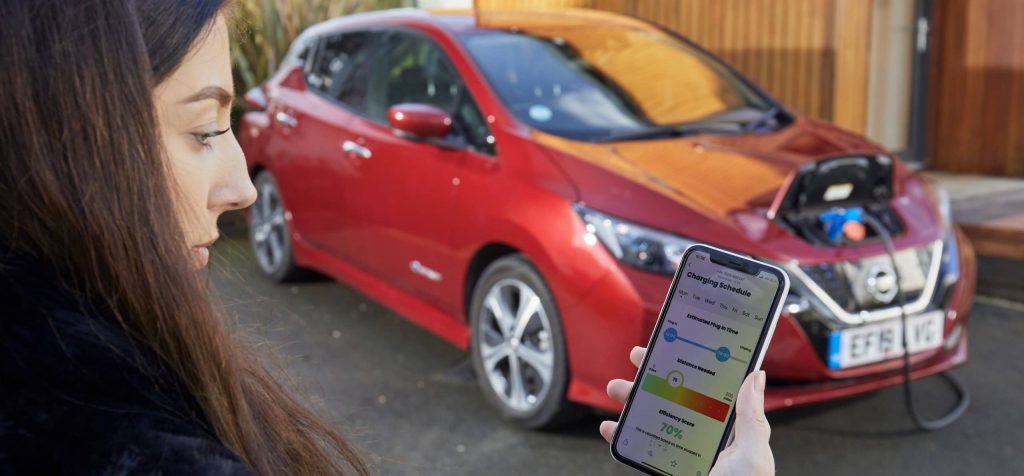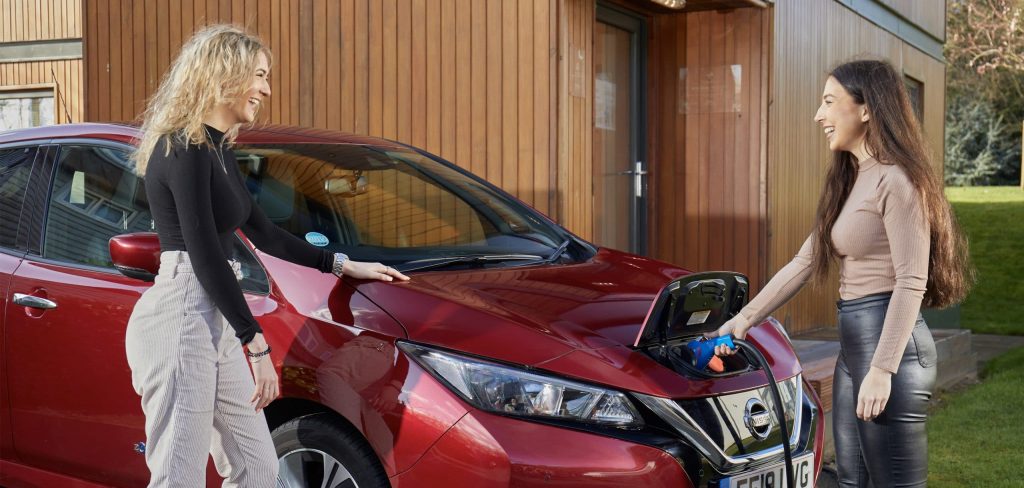The numbers of electric vehicles are set to increase. Charging these rising numbers of EVs will have an impact on local electricity networks. Smart charging, as trialled by the original Electric Nation project, will help to move demand away from peak times. However vehicle to grid charging offers a lot more than just smart charging: it offers the ability for potentially millions of EVs to smart charge using renewable energy and act as battery storage facilities, and then put energy back into the grid if needed. This means that rather than EVs being seen as a problem in relation to grid capacity, they can be an important solution to help balance the grid.

If EV owners have solar panels at home then their cars could be charged from the sun, and spare renewable energy could be put back into the grid at peak times, which would mean that the grid uses less fossil fuel generation.
For these reasons, V2G is a great concept, but it hasn’t yet been trialled sufficiently on Britain’s electricity networks to enable it to be rolled out on a country-wide basis – hence the need for this trial.
The Electric Nation Smart Charging project v the Electric Nation Vehicle to Grid project
The original Electric Nation smart charging project was scoped in 2015/16. Since then the number of plug-in vehicles on UK roads has increased nearly five-fold and will shortly pass 250,000 – and this is at a time when we are also about to see a significant rise in a wide range of low carbon technologies deployed, as the UK moves towards Net Zero.
The aims of the project
- To explore and report on the impact of V2G charging on the low voltage (LV) electricity network, utilising end-user trial charging data and analysis.
- To demonstrate, via modelling, to what extent V2G can assist with management of LV network demand.
- To examine how sophisticated dynamic bi-directional energy services based on vehicle battery storage, from a variety of energy suppliers, may impact the LV infrastructure.
- Provide recommendations of policy and commercial frameworks on V2G services.
Why the project is innovative
This project will study the real-world effects of V2G charging and look to provide a smart solution to provide management. V2G is due to become a common feature on many more vehicles with the announcement that CCS charging protocol is aiming to offer this in 2025 (CHAdeMO charging protocol does this now) along with the UK’s leading work in this field accelerating the business case for many energy suppliers.
A considerable amount of research is being carried out in the area of V2G, however this is generally supplier or charger company-led and does not focus on the likely real-world situation for a DNO should many EV users utilise this technology. In contrast, the Electric Nation Vehicle to Grid project includes multiple trading stack providers to reflect that when V2G is ‘business as usual’, multiple energy supply strategies will be in play in any given part of the LV network.
The project will operate up to five different energy supplier strategies simultaneously using V2G to imitate a future world in which many streets have a number of EVs charging in this way, operated by different energy suppliers. CrowdCharge would also look to add in smart charging data to the modelling to explore the effect of a mix of V1G and V2G. Further demand management will be trialled across the whole system to explore how much intervention is required to keep within the limitations of the low voltage network.
Scale of the project
The project will engage and recruit between 90-110 participants to install V2G charging and control equipment in domestic properties across WPD’s four licence areas. The chargers will be split into various groups of similar size and assigned to the project’s energy suppliers (up to five). Each supplier will then use their group of chargers to test their various energy services utilising CrowdCharge’s demand management charger platform which provides optimised charging sessions. The effect of these services on the LV network will be modelled and reported on, including using this real-world V2G data in a network assessment tool.
The scale size of 90-110 chargers is large enough to provide a real-world data set of the effect on the LV network and subsequently a more holistic view of the impact of V2G on the LV network in varying locations across WPD’s licence areas. A smaller sample size is unlikely to include a sufficient range of charging/driving habits of the public, thus decreasing the learning potential. As V2G is only suitable for 2-3 vehicle models, the sample size can be smaller than the Electric Nation smart charging trial from a technical standpoint.
Geographical area
The project will take place across the whole of WPD’s four licence areas (West Midlands, East Midlands, South West and South Wales).

About V2G
V2G is fundamentally different in nature to smart charging because energy can be cycled, whereas smart charging is limited to the amount of energy consumed by the EV, i.e. around 7-10KWh for a typical 28 mile a day vehicle. A vehicle charged with V2G could cycle up to 84KWh of energy in and out of the vehicle in more complex patterns trying to react to signals from the market actors. The strategies for using these services could vary significantly but also coincide, leading to unexpected peaks that could be more difficult to forecast. With the export feature this could lead to high voltage events should a national call for more energy coincide with low local load.
Electric Nation has shown that time of use tariffs may shift the evening peak and create a new peak later in the evening, leading to a need for management. Also, this would make it difficult to separate the shift in demand due to tariff or the call for Distribution Systems Operator (DSO) service – the Electric Nation Vehicle to Grid project will test a more integrated approach.
Also, when looking at the proposed services these are fairly simplistic, and they mirror how National Grid calls for flexibility – at the ends of the network with low diversity this approach is not likely to provide a complete solution. The Electric Nation Vehicle to Grid project will look to test alternative approaches with the DSO taking control only when energy supplier trading encroaches safe limits for the network.
The business case for the project
As electric vehicle numbers increase (by 2030 it is estimated that around 25% of households will have a plug-in vehicle) it is anticipated that around 5,601 substations will be running at between 100-110% capacity by 2030 at a potential reinforcement cost of around £84 million.
To maintain safe network limits, it is expected that 20% of the EV chargers would be contracted by the DSO to provide V2G balancing. This would cost £3.8 million per year, instead of an £84 million one-off reinforcement investment.
Forecasting precise impacts presents a challenge with so many changing parameters (e.g. varying uptake of EVs, domestic batteries, heat pumps, solar PV). The CrowdCharge smart service has many potential advantages:
- It offers huge flexibility. Compared to traditional reinforcement, it can be activated at shorter notice – and can be targeted very precisely. The number of chargers under control can be increased (or reduced) depending on how demand patterns evolve for each part of the network
- It will help to defer (or in some cases avoid entirely) significant amounts of reinforcement
- The solution can respond to new technology, for example can equally be applied via the same platform to utilise static domestic batteries, should they offer equivalent capacity by 2030
- The platform data will provide a broader insight to network activity, informing other network activities (for example it may support voltage monitoring)
- The £84 million estimate for traditional reinforcement assumes a planned replacement, however due to the highly distributed and unpredictable nature of EV growth (alongside equally unpredictable LCT uptake) it may require a significant percentage of emergency reinforcement as limits are breached earlier than forecasted, and therefore costs could rise significantly. In addition, emergency repairs cause greater customer impacts.
Learn more abour V2G project
What is the duration of the project?
The project started in January 2020 and will conclude in July 2022, with a one year customer trial period starting in March 2021 until March 2022.
Recruitment starts June 2020, and charger installations will start from Autumn 2020.
Who is this aimed at?
Simple if you…
- Drive a Nissan EV with a battery capacity of 30kWh or more
- Live in the Midlands, South West or South Wales
then you could be eligible to trial a domestic Vehicle to Grid (V2G) smart EV charger worth £5,500.
By plugging in at specified times and putting energy back into the grid you could be rewarded, and the charger can be kept at the end of the trial for just £250.
Lear more or enrol at Electric Nation V2G site:

